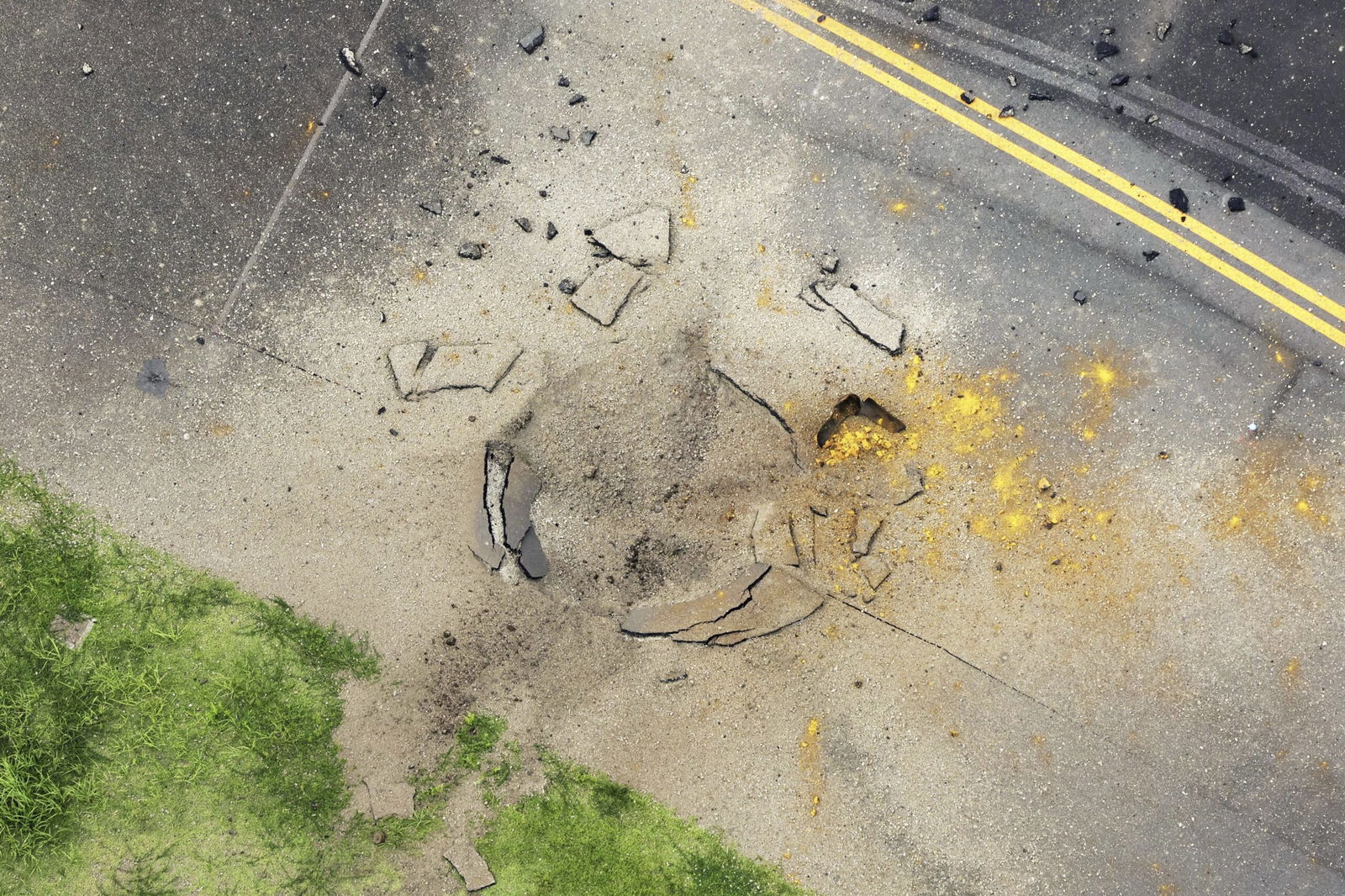Around the World briefs

By Associated Press
A U.S. bomb from World War II explodes at a Japanese airport, causing a large crater in a taxiway
TOKYO | An unexploded U.S. bomb from World War II that had been buried at a Japanese airport exploded Wednesday, causing a large crater in a taxiway and the cancellation of more than 80 flights but no injuries, Japanese officials said.
Land and Transport Ministry officials said there were no aircraft nearby when the bomb exploded at Miyazaki Airport in southwestern Japan.
Officials said an investigation by the Self-Defense Forces and police confirmed that the explosion was caused by a 500-pound U.S. bomb and there was no further danger. They were determining what caused its sudden detonation.
A video recorded by a nearby aviation school showed the blast spewing pieces of asphalt into the air like a fountain. Videos broadcast on Japanese television showed a crater in the taxiway reportedly about 7 meters (yards) in diameter and 3 feet deep.
Chief Cabinet Secretary Yoshimasa Hayashi said more than 80 flights had been canceled at the airport, which hopes to resume operations on Thursday morning.
Miyazaki Airport was built in 1943 as a former Imperial Japanese Navy flight training field from which some kamikaze pilots took off on suicide attack missions.
A number of unexploded bombs dropped by the U.S. military during World War II have been unearthed in the area, Defense Ministry officials said.
Hundreds of tons of unexploded bombs from the war remain buried around Japan and are sometimes dug up at construction sites.
Swine fever sweeps Italy’s north, threatening production of prized prosciutto and livelihoods
CORTELEONA E GENZONE, Italy | One of Giovanni Airoli’s sows tested positive for African swine fever in late August. Within a week, all 6,200 sows, piglets and fattening pigs on his farm south of Milan were slaughtered under strict protocols to halt the disease threatening Italy’s 20 billion euro prosciutto, cured sausage and pork industry.
Since swine fever appeared on the peninsula in January 2022, Italy has killed nearly 120,000 pigs — three-quarters of those over the past two months alone as the emergency intensified.
“It’s a desolation,” Airoli said outside his farm in the northern Lombardy region that is ground zero for Italy’s swine fever epidemic. No one is allowed in and out except for employees, and then under strict hygiene protocols that require clean coveralls and boots for use only inside the premises.
“It happened to us despite applying all of the safety measures required. There was obviously a failure. We don’t understand what it could have been,” Airoli said.
The disease spiked with 24 outbreaks in early September, most of them in Lombardy. The area of greatest concern, where the dissease has been confirmed in domestic pigs, extends 4,500 square kilometers (nearly 1,740 square miles) and includes neighboring Piedmont and Emilia Romagna, a region world renowned for its prized Parma prosciutto.
The impact of the swine fever outbreak goes further. Farmers in the 23,000-square kilometer (8,880-square mile) area also face restrictions due to infected wild boars, or because they fall in a buffer zone.
The disease, which is nearly always fatal to swine, first infected wild boars and quickly spread to domestic pigs, which number 10 million in Italy. It does not affect humans.
Coldiretti, Italy’s powerful agricultural lobby group, estimates damage to the industry so far at 500 million euros ($554 million), partly due to import bans, and warns that some farmers risk losing their livelihoods.
According to its calculation, the sector generates 20 billion euros ($22 billion) along the supply chain, from farms where the pigs are raised to factories where ham is cured.
“The spread of swine fever has reached alarming levels, putting at risk not just the health of the animals but of the entire pork sector,” Confindustria President Ettore Prandini warned in a recent letter to the agricultural minister.
The government appointed a new special commissioner to tackle the epidemic over the summer, tapping Giovanni Filippini, a trained veterinarian and longtime Italian animal health authority director who eradicated swine fever from the island of Sardinia.
Two previous commissioners focused efforts on dispatching the army to hunt wild boar, hitting resistance from sport hunters and the European Union, which underscored that hunting risked sending infected animals into new areas.
Instead, Filippini has imposed new restrictions on accessing farms and transferring animals, and enlarged the buffer zones, measures that seem to be having an impact. In Lombardy, just one new outbreak was reported during the last full week of September.
“It is a positive sign, but not yet a victory,” said Giovanni Loris Alborali, director of the animal health institute for Lombardy and Emilia Romagna. “We must keep the sanitation high and this will help the animals’ health with better growth rates for farmers and fewer antibiotics for consumers in the future.”
As soon as the swine fever was confirmed in Italy, 12 countries, including China, Taiwan and Mexico, put an immediate ban on importing Italian pork delicacies, like prosciutto crudo, no matter if they were produced in an area where swine fever was detected or not. Japan, South Korea and four other countries limited imports.
That brought an immediate loss of 20 million euros ($22 million) a month in exports for a sector that recorded 2.1 billion euros ($2.3 billion) in sales last year, according to the Assica association of Italian meat industries.
Markets like the United States and Canada did not stop their imports of pork products, as long as they came from areas not affected by swine fever.
Airoli, who produces ham for both San Daniele and Parma prosciutto, like many other farmers, does not expect to restart his business raising some 13,000 pigs a year until swine fever is brought under control. And there is no indication when that might be.
That’s having an impact on Italy’s prosciutto production.
“The limited availability of fresh pork legs is generating strong production limitations,” according to a statement by the Parma Prosciutto Consortium, which produces prosciutto with the certificate of origin designed to protect high-quality foods made by traditional methods. It added that a spike in prices of the raw materials due to the emergency was also “unsustainable.”
Farmers who are still outside the areas of concern are taking extra measures in an effort to ensure the disease does not reach them. Once detected, all pigs on the farm, even if healthy, must be killed.
Sergio Visini, who runs the antibiotic-free Piggly farm in the eastern Mantova province of Lombardy, requires trucks transporting pigs to be sanitized a second time when they enter the sterile zone where the pigs are held.
“We do another detailed sterilization of all of the wheels and any part of the truck that could bring contamination,” said Visini, who opened the farm in 2017 with the aim of raising pigs with less stress and more space. He hopes more farmers will adopt his methods.
“This outbreak can also turn into an opportunity to improve animal health and welfare,” he added.
Swiss glaciers are receding again after two punishing years and
despite a good start to 2024
GENEVA | The volume of Switzerland’s glaciers shrank again this summer, compounding the negative impact of climate change after a devastating two-year run that depleted the ice by more than 10%, scientific experts reported Tuesday.
The cryosphere observation team at the Swiss Academy of Sciences reported that high temperatures in July and August, combined with the heat-absorbing impact of reddish-yellow dust blown northward from the Sahara Desert onto Swiss glaciers, led to a loss of 2.5% of their volume this year.
The shrinkage came despite “extremely favorable” conditions through June, the academy said, thanks to 30% more snowfall in the preceding winter compared to average levels, meaning that the glaciers had an extra layer of protective covering of snow — before temperatures rose.
“August saw the greatest loss of ice recorded since measurements began,” the academy said in a statement summarizing the findings.
“The retreat of the glacier tongues and their disintegration continue unabated as a result of climate change,” it said, adding that the 2.5% loss of volume was higher than the average levels over the last decade.
Experts at the Glacier Monitoring in Switzerland network, known as GLAMOS, said that more than half of the glaciers it monitored completely lost their snow coverage throughout the summer.
Several topmost measurement points on glaciers, such as Plaine Morte and Gries in the south and Silvretta in the east, recorded melt rates of a meter or more, the network said in a report for the Swiss Academy of Sciences.
GLAMOS cited three factors: “very high” average air temperatures in July and August; good weather in those months in which there was no fresh snow; and southwesterly winds in the winter and spring that dumped the Saharan dust onto the Alps, causing a warming effect on the ice.
Switzerland is home to the most glaciers of any country in Europe, and saw 4% of its total glacier volume disappear last year. That was the second-biggest decline in a single year on top of a 6% drop in 2022.
The UK and EU vow to mend their Brexit battered ties. They will set a new agenda and hold summits
BRUSSELS | The United Kingdom and the European Union agreed on Wednesday to strengthen their relationship after the damage caused by Brexit and to hold a series of meetings, including at the highest level, on issues like economic growth, energy, security and migration.
In a statement issued after talks in Brussels, U.K. Prime Minister Keir Starmer and European Commission President Ursula von der Leyen agreed on “the importance of the unique relationship” they share and vowed to “ambitiously” strengthen their cooperation.
The leaders both recommitted to the Withdrawal Agreement and other pacts reached on the terms of Brexit as Britain left the world’s biggest trade bloc four years ago, the first country to do so, creating a deep rift between them.
They also reaffirmed their commitment to uphold international law and to the European Convention on Human Rights. Hard-line Brexiteers want the U.K. to leave the convention so that asylum-seekers can be deported without the intervention of rights courts.
Britons voted to leave the EU during the 2016 Brexit referendum, when a key promise of the campaign to exit was that it would give the U.K. more control over its borders. But immigration figures have gone up, not down, since then.
Von der Leyen and Starmer underlined the shared challenges that they face, notably because of Russia’s full-fledged invasion of Ukraine, and they both “reiterated their unwavering support for Ukraine’s sovereignty.”
They said that “a stable, positive and forward-looking relationship was in their mutual interests and provided the basis for long term cooperation.” An agenda for their cooperation will be established in coming months.
It would start by “defining together the areas in which strengthened cooperation would be mutually beneficial, such as the economy, energy, security and resilience, in full respect of their internal procedures and institutional prerogatives.”
The two said they would meet again in the fall, and that the first of what should become a regular series of EU-U.K. summits should be held early next year.
Earlier, standing alongside von der Leyen, Starmer told reporters that he believes “the British public want to return to pragmatic, sensible leadership when it comes to dealing with our closest neighbors, to make Brexit work and to deliver in their interests, to find ways to boost economic growth, strengthen our security and tackle shared challenges like irregular migration and climate change.”
Von der Leyen welcomed his visit and the opportunity to strengthen EU-U.K. relations.
“We have a set of solid agreements in place,” she said. “We should explore the scope for more cooperation while we focus on the full and faithful implementation” of the Brexit agreements underpinning their painful and costly divorce.
Starmer also held talks with the other leaders of the bloc’s main institutions: European Council President Charles Michel and European Parliament President Roberta Metsola.
The EU, for its part, wants to build bridges between young people on either side of the English Channel by introducing a program that would allow young EU and U.K. citizens to study, work and live for short periods in the U.K. and the EU, respectively. Supporters of Brexit oppose it.
Since his center-left Labour Party’s resounding election win on July 4, Starmer has sought a larger role for the United Kingdom on the global stage after years of soured relations with Europe over Brexit.
He has vowed to reduce some of the post-Brexit barriers for people and goods that have undermined ties between Britain and the bloc. Starmer insists, though, that he won’t reverse Brexit, or rejoin the EU’s single market and customs union.
—From AP reports


